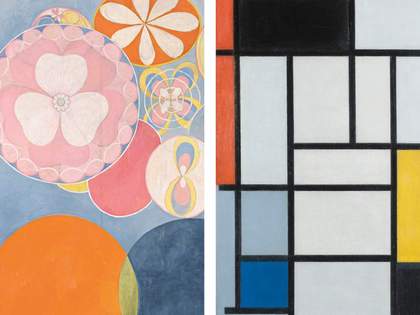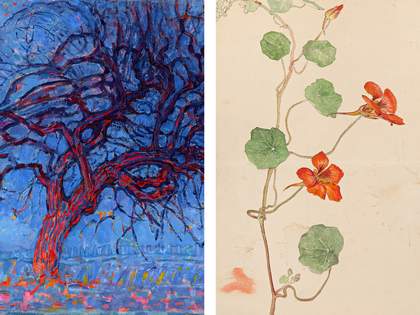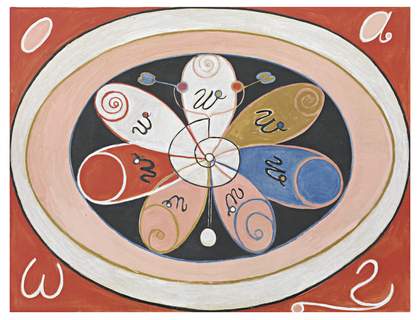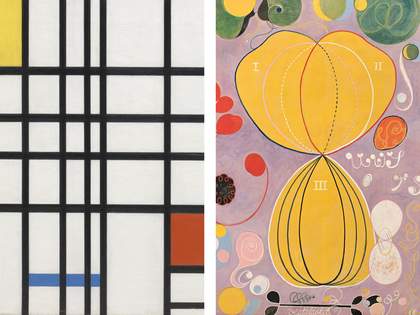
Left: Hilma af Klint The Ten Largest, Group IV No.2, Childhood 1907 Hilma af Klint Foundation. Right: Piet Mondrian Composition with Red, Black, Yellow, Blue and Gray 1921 Kunstmuseum Den Haag
Two groundbreaking artists brought together for the first time

Left: Hilma af Klint The Ten Largest, Group IV No.2, Childhood 1907 Hilma af Klint Foundation. Right: Piet Mondrian Composition with Red, Black, Yellow, Blue and Gray 1921 Kunstmuseum Den Haag
Though they never met, Swedish painter Hilma af Klint and Dutch painter Piet Mondrian went on parallel journeys to create daring new kinds of abstract art.
Let’s look at some reasons why they make a perfect pairing.

Piet Mondrian Evening; The Red Tree 1908–1910 Kunstmuseum den Haag
Hilma af Klint Botanical Drawing circa 1890 The Hilma af Klint Foundation
Hilma af Klint (1862-1944) and Piet Mondrian (1872-1944) both trained as landscape painters. Fascinated by the beauty of nature, they started out painting and drawing the natural world around them, mainly flowers, plants and trees. Mondrian drew or painted mostly vibrant single flowers, like lilies and chrysanthemums. Even when he began to create abstract compositions, he continued to paint flowers late into his career.
Af Klint studied painting and drawing at Stockholm’s Royal Academy of Fine Arts. After graduating, she became recognised for her striking botanical drawings, also of blooming flowers and plants. Trees were another common thread in both artists' work. Their trees explored ideas around balance and harmony – Mondrian’s gradually became more abstract over time.

Hilma af Klint The Evolution, The WUS/Seven-Pointed Star Series, Group VI, No. 15 1908 The Hilma af Klint Foundation
As they began to develop new abstract styles of painting, their ideas were shaped by science, spirituality and philosophy. They were also inspired by invisible worlds – things not seen by the naked eye such as radioactivity and electrons. One of these ideas was Theosophy, a spiritual movement that said everything in the universe is connected.
Mondrian thought art was a way he could explore something spiritual and universal – he believed his work had the power to reveal what he called the 'spiritual realm.' Af Klint was a medium and deeply spiritual. She believed her paintings, like The Ten Largest, were guided by higher powers.

Piet Mondrian Composition with Yellow, Blue and Red 1937-42 Tate Purchase 1964
Hilma af Klint The Ten Largest, Group IV, No. 7, Adulthood 1907 The Hilma af Klint Foundation
The artists weren’t just focused on nature-based works. They eventually went beyond traditional painting to develop bold new styles of abstract painting.
Mondrian created Neo-plasticism – the grid-like works he is best known for today. Af Klint transformed petals and florals into her own recognisable style of art, bursting with circles and swirls of radiant colour. She eventually asked that her abstract paintings be kept hidden for twenty years after her death, believing the world was not ready to experience them.
Hilma af Klint & Piet Mondrian is on at Tate Modern until 3 September 2023